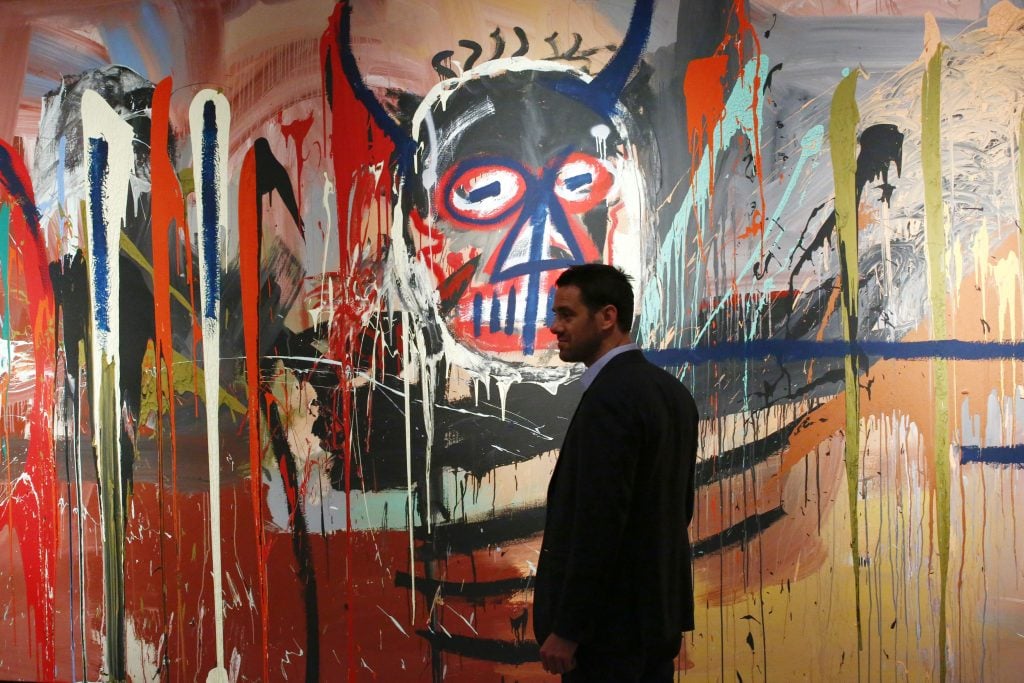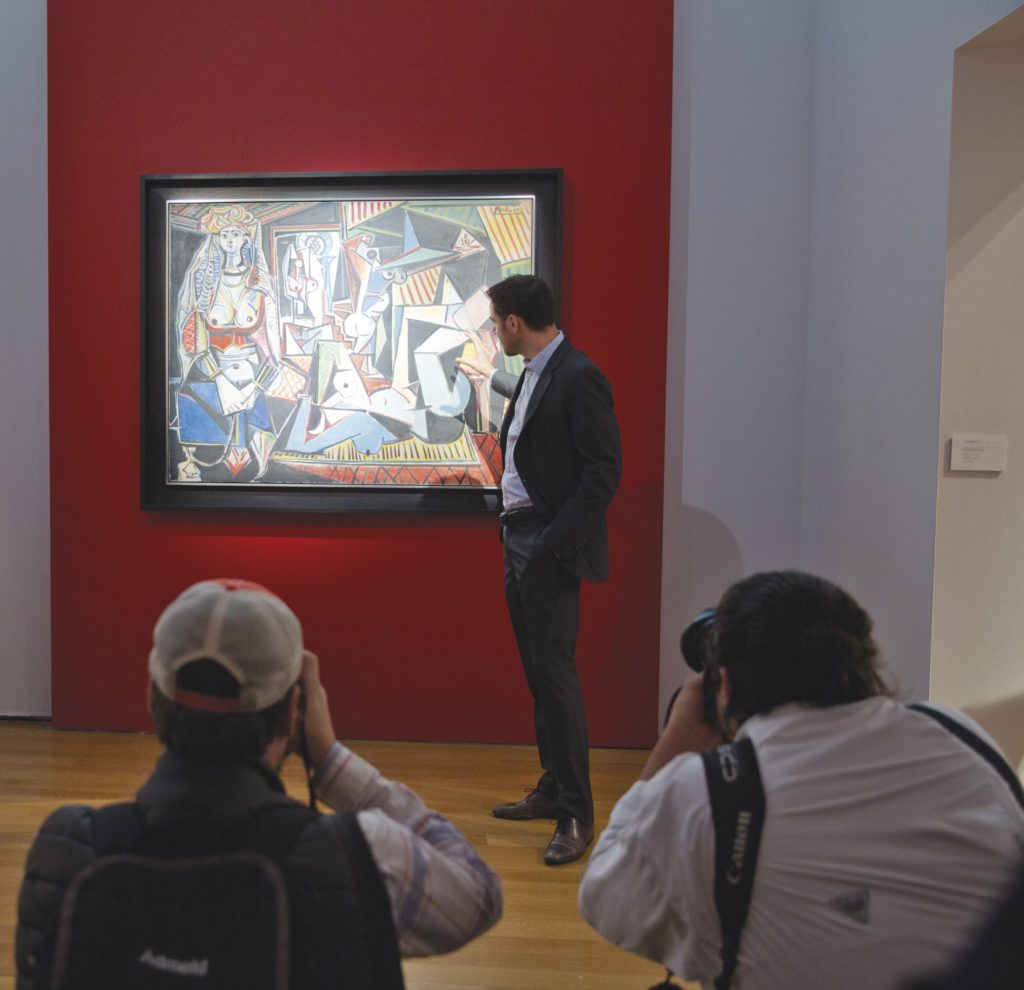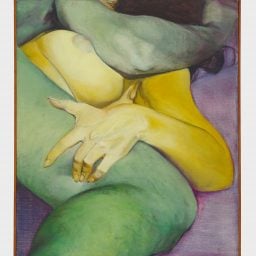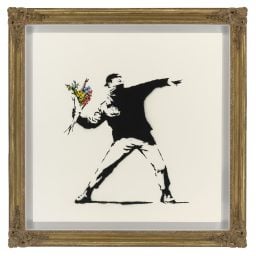When Loïc Gouzer was head of contemporary art at Christie’s, he would assemble elaborate themed sales studded with holy-grail consignments. To do so, he would jet around the world for months before an auction, parachuting into art-filled homes and convincing collectors to part with their treasures.
But when it came time to build his own auction house—a paddle-waving platform called Fair Warning, which debuted this week—he did it all in his garage in Montauk, with a runtime of just a few weeks.
“Loïc has been aware of the opportunity for a long time but it’s not something we discussed seriously until six weeks ago,” said Alexandra Bonetti, the tech developer and founder of fitness-professional platform Talent Hack, who built out the app with Gouzer.
“I was like, are you sure you could do that so fast?” Gouzer chimed in on a call earlier this week.
“It’s been a rush, no question,” Bonetti replied. “We haven’t slept in a month and a half.”
This Sunday, ahead of the hybrid virtual-in person marquee auctions at Sotheby’s, Christie’s, and Phillips, Gouzer and Bonetti’s app will make its first offering, after which one work will follow every Sunday, unless Gouzer takes a week off—or two, or three, he admitted—to go deep-sea fishing in the Atlantic.

Fair Warning in the iPhone app store. Photo courtesy Fair Warning.
Back to the Gavel
Once known for his ability to build brawny and brainy evening sales—and winning lots for clients who could spend hundreds of millions of dollars on a single work—Gouzer has been under the radar since his surprise departure from Christie’s at the end of 2018.
Since then, he’s dipped his toe back into the auction sphere just once. A longtime champion of environmental causes, Gouzer helped Art to Acres arrange for a charity auction of a painting by Jonas Wood at Christie’s May 2019 evening sale to fund a nature reserve in the Colombian rainforest. (Estimated at $500,000 to $700,000, it sold for $4.9 million.)
He was mostly quiet for the next year. Then, months into a quarantine spent at his house in Montauk, sometimes surfing with collector Adam Lindemann, he began perusing online art platforms—not to check out the competition, but to buy some works.
“The galleries bombard you with stuff, and then it’s not very transparent—you think it’s sold but it’s not sold, you think it’s not sold and it’s sold,” he said. “I was starting to get annoyed.”

Loic Gouzer Deputy Chairman, Post-War and Contemporary at Christie’s stands next to the artwork ‘Untitled’ made by artist Jean-Michel Basquiat on April 29, 2016l. AFP / KENA BETANCUR)
While many galleries and auction houses are emailing collectors fat tranches of artwork and content, Gouzer decided to do the opposite—create a pared-down system. “You don’t have to sort through many many works in order to find a gem,” he said. “We’re doing that job for people.”
Before long, Bonetti began working on the back end, and Gouzer cleared out his garage in Montauk to store and shoot the works. (“Alexandra’s like a war machine—she finished first at Wharton… there’s a statue of her in the lobby,” Gouzer said.)
Still, he had one more challenge to tackle: figuring out how to digitally deliver the lightning-in-a-bottle energy of the last few seconds of bidding on a live sale’s top lot—the one that comes just as the auctioneer, gavel aloft, bellows “fair warning!”
That’s why bidding starts at 5:00 p.m. sharp on Sundays. Those who want to place a bid swipe right on the app, à la Tinder. The proceedings end when no one can top a price. As a counter to the exceedingly choreographed evening sales we have grown accustomed to, there are no absentee bids. Those who are late miss out.

Christie’s rainmakers Alex Rotter and Loïc Gouzer celebrate after the gavel goes down. (Photo by Eduardo Munoz Alvarez/Getty Images)
More Soho House Than Auction House
The works on offer may not have the price point of, say, a certain Leonardo that Gouzer helped bring to auction in 2017, but they come heavily vetted, with built-in markets. A 15 percent buyers’ premium will be tacked on to all works (less than the 20 to 25 percent major auction houses charge on sales up to $4 million).
The first lot on the Fair Warning digital block is a painting by Steven Shearer, a cultish portrait painter who hasn’t had a major museum show in the US but is highly sought after by a handful of heavyweight collection-building machers. The newsprint baron Peter Brant has a large trove of Shearers, which he trotted out for a show at his Greenwich, Connecticut art foundation in late 2016. (The provenance of the Shearer that Gouzer is selling, Synthist (2018), includes “Private Collection, CT.”) It is estimated to sell for $180,000 to $250,000, which would blitz past the artist’s current record of about $164,000.
Also heavily vetted are the people allowed to participate. While Sotheby’s, Christie’s, and the rest often promote themselves as the most democratic outlet in the art market (have money, can bid), Gouzer’s approach is more Soho House than auction house. You have to be invited or apply, and spots are limited. A number of buyers and advisors in his circle beta-tested the app in the last few weeks—he would not mention any names, though he is close with collectors such as tennis great Roger Federer and actor and environmentalist Leonardo DiCaprio—and invites went out this week.
“Usually you test something internally, you deploy it externally, and you put that feedback in,” Bonetti said. “That’s usually a few months. For us, it was a few days.”
The demand was immediate. Gouzer said that he got 3,000 applications in the first week, and was only accepting a tiny fraction in order to keep the membership exclusive, ensuring an ambience more akin to the screened-off skyboxes above the salesroom than the stuffed rows below.
“There’s no runners, there’s no trash-taking or shopping around pictures—it’s about creating a community,” Gouzer said. “At least for now, we have a certain amount of people that we’re going to take, and the closer we get to that number the harder it’ll be to get in. The whole idea is to keep it private so people can feel comfortable.”

Gouzer with Picasso’s Les femmes d’Alger (Version ‘O’), 1955. Photo courtesy of Christie’s.
“I’m Being Very, Very Picky.”
Also in limited supply, at the moment, are adequate consignments, due at least somewhat to Gouzer’s strict sniff test. “I’m being bombarded with artworks but I’m being very, very picky,” he said. “That’s going to be the real challenge.”
He believes he can expand the model if all goes well, likening Fair Warning to open-source code that can be constantly tweaked. Asked about long-term plans, Gouzer said, “What we want to do is sell the entire thing to eBay!” (He was joking, I think.)
And for the second week of Fair Warning, Gouzer secured a choice consignment from a very stubborn collector: Loïc Gouzer. The app-owner himself is offering a David Hammons from his own collection.
“I really, really don’t want to sell this work, but it was hard to get consignments before we had an auction house that anyone knew about,” he said. “At the end of the day, I’m willing to be the guinea pig.”













